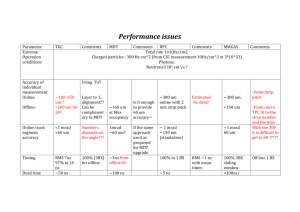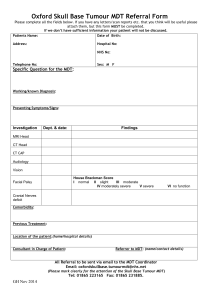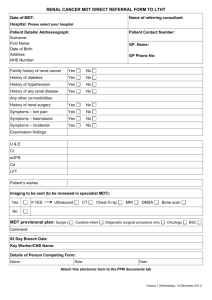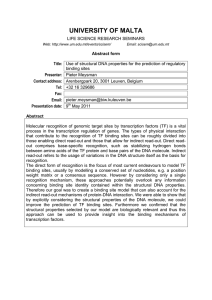A new Highly Selective First Level ATLAS Muon Trigger With MDT
advertisement
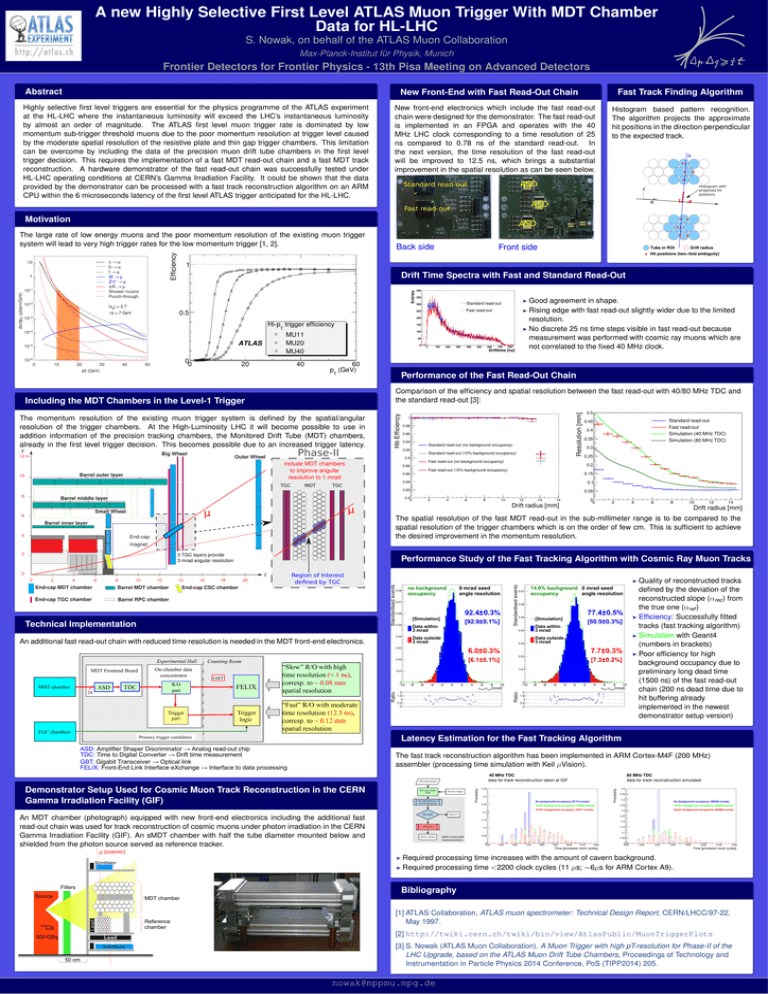
A new Highly Selective First Level ATLAS Muon Trigger With MDT Chamber Data for HL-LHC S. Nowak, on behalf of the ATLAS Muon Collaboration Max-Planck-Institut für Physik, Munich Frontier Detectors for Frontier Physics - 13th Pisa Meeting on Advanced Detectors Abstract Highly selective first level triggers are essential for the physics programme of the ATLAS experiment at the HL-LHC where the instantaneous luminosity will exceed the LHC’s instantaneous luminosity by almost an order of magnitude. The ATLAS first level muon trigger rate is dominated by low momentum sub-trigger threshold muons due to the poor momentum resolution at trigger level caused by the moderate spatial resolution of the resistive plate and thin gap trigger chambers. This limitation can be overcome by including the data of the precision muon drift tube chambers in the first level trigger decision. This requires the implementation of a fast MDT read-out chain and a fast MDT track reconstruction. A hardware demonstrator of the fast read-out chain was successfully tested under HL-LHC operating conditions at CERN’s Gamma Irradiation Facility. It could be shown that the data provided by the demonstrator can be processed with a fast track reconstruction algorithm on an ARM CPU within the 6 microseconds latency of the first level ATLAS trigger anticipated for the HL-LHC. New front-end electronics which include the fast read-out chain were designed for the demonstrator. The fast read-out is implemented in an FPGA and operates with the 40 MHz LHC clock corresponding to a time resolution of 25 ns compared to 0.78 ns of the standard read-out. In the next version, the time resolution of the fast read-out will be improved to 12.5 ns, which brings a substantial improvement in the spatial resolution as can be seen below. Histogram based pattern recognition. The algorithm projects the approximate hit positions in the direction perpendicular to the expected track. μ Histogram with projected hit positions y α z Motivation The large rate of low energy muons and the poor momentum resolution of the existing muon trigger system will lead to very high trigger rates for the low momentum trigger [1, 2]. Efficiency dσ/dpT (µbarn/GeV) 10–1 10–2 Drift Time Spectra with Fast and Standard Read-Out |ηµ| < 2.7 0.5 √s = 7 GeV 10–3 T ATLAS 10–5 10 20 30 µ pT (GeV) 40 0 0 50 100 20 50 0 40 60 p (GeV) TGC 8 6 400 500 600 700 800 Drifttime [ns] 0.96 0.94 MDT Standard read-out (no background occupancy) 0.92 Standard read-out (10% background occupancy) 0.9 μ μ Standard read-out Fast read-out Simulation (40 MHz TDC) Simulation (80 MHz TDC) 0.45 0.4 0.35 0.3 0.25 0.2 Fast read-out (10% background occupancy) 0.86 TGC 0.5 Fast read-out (no background occupancy) 0.88 0.15 0.84 0.1 0.82 0.05 0.8 0 2 4 6 8 10 12 14 0 0 16 Drift radius [mm] 2 4 6 8 10 12 14 Drift radius [mm] The spatial resolution of the fast MDT read-out in the sub-millimeter range is to be compared to the spatial resolution of the trigger chambers which is on the order of few cm. This is sufficient to achieve the desired improvement in the momentum resolution. Barrel inner layer 4 300 0.98 Barrel middle layer Small Wheel 200 1 include MDT chambers to improve angular resolution to 1 mrad Barrel outer layer 10 Phase-II Outer Wheel Hit-Efficiency The momentum resolution of the existing muon trigger system is defined by the spatial/angular resolution of the trigger chambers. At the High-Luminosity LHC it will become possible to use in addition information of the precision tracking chambers, the Monitored Drift Tube (MDT) chambers, already in the first level trigger decision. This becomes possible due to an increased trigger latency. Big Wheel 100 Comparison of the efficiency and spatial resolution between the fast read-out with 40/80 MHz TDC and the standard read-out [3]: Including the MDT Chambers in the Level-1 Trigger 12 m 0 Performance of the Fast Read-Out Chain T y Fast read-out 150 MU11 MU20 MU40 Good agreement in shape. I Rising edge with fast read-out slightly wider due to the limited resolution. I No discrete 25 ns time steps visible in fast read-out because measurement was performed with cosmic ray muons which are not correlated to the fixed 40 MHz clock. I Standard read-out 300 200 Hi-p trigger efficiency 0 HPTDC Entries 104564 Mean 225.9 191.6 RMS 350 250 10–4 10–6 400 Resolution [mm] 1 Drift radius 1 Entries c→µ b→µ t→µ W→µ Z/γ* → µ π/K → µ Shower muons Punch-through 10 Tube in ROI Hit positions (two−fold ambiguity) End-cap magnet 3 TGC layers provide 3 mrad angular resolution Performance Study of the Fast Tracking Algorithm with Cosmic Ray Muon Tracks z 2 4 6 8 10 12 14 End-cap MDT chamber Barrel MDT chamber End-cap TGC chamber Barrel RPC chamber 16 18 20 End-cap CSC chamber Technical Implementation 0.08 no background occupancy 0 mrad seed angle resolution 0.07 92.4±0.3% 0.06 [Simulation] 0.05 0.04 An additional fast read-out chain with reduced time resolution is needed in the MDT front-end electronics. [92.9±0.1%] Data within 3 mrad Data outside 3 mrad 0.03 MDT chamber ASD 24 R/O part TDC Trigger part TGC chambers GBT FELIX Trigger logic “Fast” R/O with moderate time resolution (12.5 ns), corresp. to ~ 0.12 mm spatial resolution 0 iation Facility (GIF) - 2013/2014 -8 -6 -4 -2 0 2 4 8 10 αrec-αref [mrad] Filters -6 -4 -2 0 2 4 6 8 10 αrec-αref [mrad] 2 1.5 1 0.5 0 80 MHz TDC data for track reconstruction simulated 0.35 0.3 No background occupancy (8715 events) 0.25 14.0% background occupancy (10098 events) Find peak Return 0 0.2 0.45 0.4 No background occupancy (40000 events) 0.35 10.0% background occupancy (40000 events) 0.3 20.0% background occupancy (40000 events) 0.25 0.15 Fit tracks 0.5 0.2 0.15 0.1 0.1 Return results ARM Cortex-M4F implementation 0.05 0.05 0 1400 1500 1600 1700 1800 1900 2000 2100 2200 0 1500 1600 1700 1800 Time [processor clock cycles] 1900 2000 2100 [1] ATLAS Collaboration, ATLAS muon spectrometer: Technical Design Report, CERN/LHCC/97-22, May 1997. Reference chamber [2] http://twiki.cern.ch/twiki/bin/view/AtlasPublic/MuonTriggerPlots MDT chamber used for test 6 tube layers, 50 cm length MDT chamber used for test No muon beam in the GIF → use cosmic muons 6 tube layers, 50 cm length Fast read-out and normal read-out are triggered by scintillators [3] S. Nowak (ATLAS Muon Collaboration), A Muon Trigger with high pT-resolution for Phase-II of the LHC Upgrade, based on the ATLAS Muon Drift Tube Chambers, Proceedings of Technology and Instrumentation in Particle Physics 2014 Conference, PoS (TIPP2014) 205. nowak@mppmu.mpg.de 2200 Time [processor clock cycles] Bibliography MDT chamber MDT chamber Lead -8 Required processing time increases with the amount of cavern background. I Required processing time <2200 clock cycles (11 µs; ∼6µs for ARM Cortex A9). ers Lead -10 I Scintillator 50 cm Scintillator [7.3±0.2%] 19.5% background occupancy (5517 events) μ (cosmic) Scintillator Primary trigger Calculate distance d and fill histogram An MDT chamber (photograph) equipped with new front-end electronics including the additional fast read-out chain was used for track reconstruction of cosmic muons under photon irradiation in the CERN μ (cosmic) Goal: of (GIF). efficiency and chamber resolution GammaMeasurement Irradiation Facility An sMDT with half the tube diameter mounted below and shielded from the photon source served as reference tracker. Scintillator Lead 0.03 Data outside 3 mrad 40 MHz TDC data for track reconstruction taken at GIF Probability FRO Input Buffer (FIB) urement of efficiency and resolution CERN Gamma Irradiation Facility (GIF) - 2013/2014 500 GBq Data within 3 mrad The fast track reconstruction algorithm has been implemented in ARM Cortex-M4F (200 MHz) assembler (processing time simulation with Keil µVision). Demonstrator Setup Used for Cosmic Muon Track Reconstruction in the CERN TestGamma of new hardware Irradiation Facilityand (GIF) fast tracking algorithm Reference chamber Lead 0.04 0 6 FRO Data stream Cs [80.9±0.3%] Latency Estimation for the Fast Tracking Algorithm ASD: Amplifier Shaper Discriminator → Analog read-out chip TDC: Time to Digital Converter → Drift time measurement GBT: Gigabit Transceiver → Optical link FELIX: Front-End Link Interface eXchange → Interface to data processing 137 [Simulation] 0.01 2 1.5 1 0.5 0 Primary trigger candidates Source 77.4±0.5% 0.05 7.7±0.3% 0.01 -10 0.06 0.02 [6.1±0.1%] 0.02 “Slow” R/O with high time resolution (< 1 ns), corresp. to ~ 0.08 mm spatial resolution 14.0% background 0 mrad seed occupancy angle resolution 0.07 6.0±0.3% Ratio On-chamber data concentrator MDT Frontend Board Counting Room Ratio Experimental Hall Quality of reconstructed tracks defined by the deviation of the reconstructed slope (αrec ) from the true one (αref ) I Efficiency: Successfully fitted tracks (fast tracking algorithm) I Simulation with Geant4 (numbers in brackets) I Poor efficiency for high background occupancy due to preliminary long dead time (1500 ns) of the fast read-out chain (200 ns dead time due to hit buffering already implemented in the newest demonstrator setup version) I Probability 0 Region of Interest defined by TGC Standardised events 0 Standardised events 2 w hardware and fast tracking algorithm 0 cm Fast Track Finding Algorithm New Front-End with Fast Read-Out Chain
